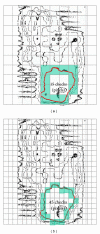Dose verification in intensity modulation radiation therapy: a fractal dimension characteristics study
- PMID: 23956976
- PMCID: PMC3722795
- DOI: 10.1155/2013/349437
Dose verification in intensity modulation radiation therapy: a fractal dimension characteristics study
Abstract
Purpose: This study describes how to identify the coincidence of desired planning isodose curves with film experimental results by using a mathematical fractal dimension characteristic method to avoid the errors caused by visual inspection in the intensity modulation radiation therapy (IMRT).
Methods and materials: The isodose curves of the films delivered by linear accelerator according to Plato treatment planning system were acquired using Osiris software to aim directly at a single interested dose curve for fractal characteristic analysis. The results were compared with the corresponding planning desired isodose curves for fractal dimension analysis in order to determine the acceptable confidence level between the planning and the measurement.
Results: The film measured isodose curves and computer planning curves were deemed identical in dose distribution if their fractal dimensions are within some criteria which suggested that the fractal dimension is a unique fingerprint of a curve in checking the planning and film measurement results. The dose measured results of the film were presumed to be the same if their fractal dimension was within 1%.
Conclusions: This quantitative rather than qualitative comparison done by fractal dimension numerical analysis helps to decrease the quality assurance errors in IMRT dosimetry verification.
Figures







Similar articles
-
Clinical experience with EPID dosimetry for prostate IMRT pre-treatment dose verification.Med Phys. 2006 Oct;33(10):3921-30. doi: 10.1118/1.2230810. Med Phys. 2006. PMID: 17089854
-
A dose delivery verification method for conventional and intensity-modulated radiation therapy using measured field fluence distributions.Med Phys. 2003 Nov;30(11):2996-3005. doi: 10.1118/1.1610771. Med Phys. 2003. PMID: 14655947
-
The evolution of quality assurance for intensity- modulated radiation therapy (IMRT): sequential tomotherapy.Int J Radiat Oncol Biol Phys. 2003 May 1;56(1):274-86. doi: 10.1016/s0360-3016(03)00097-x. Int J Radiat Oncol Biol Phys. 2003. PMID: 12694849
-
Fractal analysis of normal retinal vascular network.Oftalmologia. 2011;55(4):11-6. Oftalmologia. 2011. PMID: 22642130 Review.
-
Fractal Analysis in MATLAB: A Tutorial for Neuroscientists.Adv Neurobiol. 2024;36:815-825. doi: 10.1007/978-3-031-47606-8_41. Adv Neurobiol. 2024. PMID: 38468065 Review.
References
-
- Nauta M, Villarreal-Barajas JE, Tambasco M. Fractal analysis for assessing the level of modulation of IMRT fields. Medical Physics. 2011;38(10):5385–5393. - PubMed
-
- Lee T-F, Fang F-M, Chao P-J, Su T-J, Wang LK, Leung SW. Dosimetric comparisons of helical tomotherapy and step-and-shoot intensity-modulated radiotherapy in nasopharyngeal carcinoma. Radiotherapy and Oncology. 2008;89(1):89–96. - PubMed
-
- Clemente S, Wu B, Sanguineti G, et al. SmartArc-based volumetric modulated arc therapy for oropharyngeal cancer: a dosimetric comparison with both intensity-modulated radiation therapy and helical tomotherapy. International Journal of Radiation Oncology Biology Physics. 2011;80(4):1248–1255. - PubMed
-
- Tambasco M, Nygren I, Villarreal-Barajas J, Sci-Thur AM. Planning-09: assessing dynamic IMRT field modulation in prostate plans. Medical Physics. 2012;39(7) - PubMed
MeSH terms
LinkOut - more resources
Full Text Sources
Other Literature Sources
Medical

